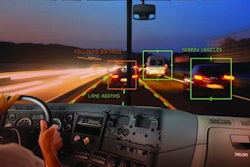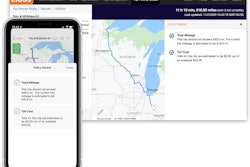There’s also more under the surface that can help fleets improve safety and efficiency. Dwayne Lazarre, director of strategic accounts for Trimble MAPS, said providing drivers with as much information as possible to help them avoid problematic situations can go a long way toward improving safety.
Systems like Trimble’s CoPilot Truck navigation app allow fleets to customize drivers’ routes to give them the most accurate directions to a specific location, while also providing drivers with traffic slowdown alerts and more while en route to help them stay safe.
“As a driver, you can’t always control if you can be in the right place at the right time or not, but sometimes accidents happen,” Lazarre said. “And if there’s an accident happening…ahead of you, it would be a good idea for you to have an idea that, ‘hey, all of a sudden traffic is going to decrease from 65-70 miles per hour, and it’s going to come down to a screeching halt, so let’s give you a warning. Let’s give you some additional indication.’”
Fleets and drivers can also specify what kind of vehicle they’re using, including height, width and weight, to make sure the driver is on a legal route, Lazarre added.
“Once you mix those two things together, and then you can enhance it with things like speed alerts, so if your driver is over-speeding, let’s make sure the driver is aware,” he said. “Let’s give you some additional indicators in-cab that can help with that.”
 Hear more about improving driver safety and efficiency with routing tools on this week's 10-44 webisode in the video above.
Hear more about improving driver safety and efficiency with routing tools on this week's 10-44 webisode in the video above.
With back-office tools, fleet managers or dispatchers can also have input in the routes drivers take. If a particular route has proven to be problematic for traffic slowdowns, speeding, high risk of rollovers and more, Lazarre said fleets have the ability to deliver more accurate information to their drivers to avoid those areas.
“All those outliers, all those things I know are ‘gotchas,’ I can take the majority of those out of the equation for my driver,” he said. “And, if I do have to put my driver in an instance where regardless of what they do you have to go by this speed trap, I can flag that. So when my driver is going down that road, they can get an indicator that lets them know, ‘hey, this is going to be a speed trap.’”
Lazarre added that if a dispatcher knows a customer’s shipping and receiving area has an entrance that’s not clearly marked on a map, he or she can put that specific location in the system to make sure the driver knows where to go to load or unload, making the most of the driver’s time.
“I can ensure that you arrive on time because I gave you the right directions, after you got off the interstate I told you the [correct] lefts and rights to make, and at the same time, I delivered you to the correct entry point to the facility,” he said. “I didn’t just say, ‘hey, here’s the facility on the map, good luck.’ I said here’s the facility; here’s how you enter the facility; when you get to the facility, here’s the gate code; here’s what dwell times look like; once you’re inside the facility, you need to go to this particular loading bay; and once you’re done loading or unloading, here’s how you exit the facility to purposefully take you on to your next destination.”













